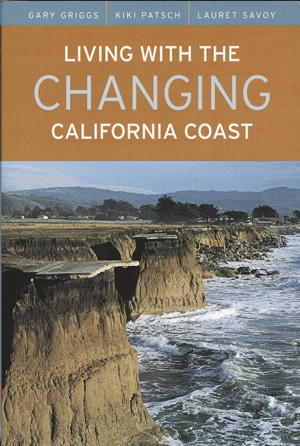The famously beautiful California coast is a powerful attractor, drawing people to live and build in the coastal zone despite ongoing erosion, periodic storm damage, and regulatory hurdles. For those determined to live next to this dynamic shoreline, the new book Living with the Changing California Coast should be required reading.
Written by Gary Griggs, Kiki Patsch, and Lauret Savoy, with contributions from more than a dozen other coastal experts, the book was released in November from the University of California Press. It is a completely revised and updated edition of the 1985 book Living with the California Coast, by Griggs and Savoy. Griggs is a professor of Earth sciences and director of the Institute of Marine Sciences at the University of California, Santa Cruz. Patsch and Savoy both worked with Griggs as graduate students, and Patsch is now a postdoctoral researcher at the University of Virginia, while Savoy is a professor of geology and environmental studies at Mount Holyoke College.
The first part of the book provides a wealth of background information on coastal processes and hazards, with advice for home buyers, residents, coastal managers, and developers. There are sections on climate change, rising sea levels, coastal erosion, responding to coastal hazards, and coastal policy and legislation. The second part of the book consists of 12 chapters, each providing a comprehensive discussion of one geographic section of the coast.
"There has been a lot of investment on the coast, both public and private, so we need to heighten people's awareness of these issues," Griggs said.
Much has changed in the 20 years since the first edition appeared. People have continued to move to the coast, property values have skyrocketed, and the coast has been battered by stronger and more frequent storms. Starting with the El Niño event of 1978, the coastal climate shifted from a more moderate phase of its cycle to a period dominated by major El Niño events that bring powerful and destructive storms to the California coast.
"We entered this period of big El Niño events, with stronger storms, more cliff retreat, more beach erosion, and more seawall proposals. The combination of more people, more hazards, and higher property values has focused a lot of attention on this narrow strip of shoreline that is constantly changing," Griggs said.
The book includes nearly 300 photographs and 81 detailed maps covering the entire coast. Patsch prepared the maps using geographic information system (GIS) technology to provide precise information on geologic hazards along all 1,100 miles of the California coastline. The maps include hazard ratings, erosion rates where available, descriptions of coastal landforms, locations of seawalls and other types of armoring, and other useful and interesting information about every stretch of shoreline.
The photographs include dramatic illustrations of damage to coastal structures, as well as extensive documentation of natural and man-made features along the coast. Many of the photos were provided by the California Coastal Records Project, which includes photographs of the entire coastline on its web site (www.Californiacoastline.org).
"We have much better photo coverage of the coast in this edition, and the GIS-based maps are more accurate and easier to read," Griggs said.
Living with the Changing California Coast is an essential resource for those intending to buy or build along the coast, for planners in coastal cities and counties, and for anyone who needs or wants specific information about California's various coastal regions. Aside from its practical value, the book provides a fascinating look at one of the most beautiful coastlines in the world, with information on its natural history, the forces that have shaped it, and how it continues to evolve over time.
"I think it should appeal to anybody who is interested in the coast and curious about the way the coastline operates, how it changes, and what are the issues we face in dealing with coastal hazards," Griggs said.



